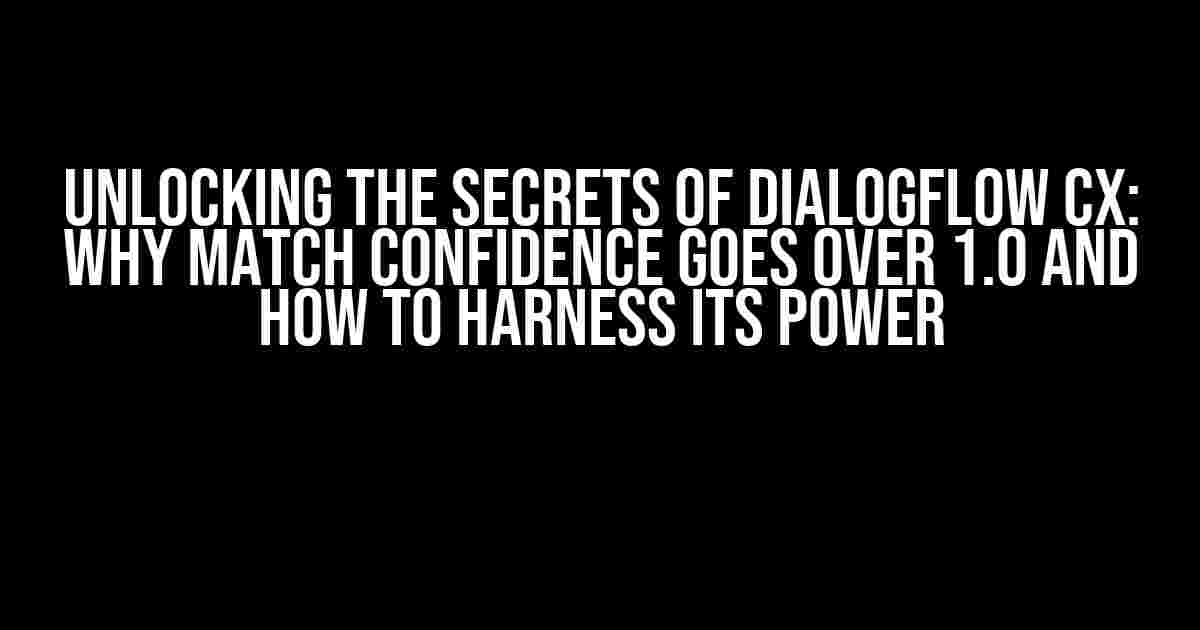Are you tired of struggling with chatbot responses that seem to lack accuracy and intent? Do you find yourself wondering why your Dialogflow CX agent’s match confidence level keeps exceeding 1.0? Fear not, dear developer, for today we’re going to dive into the mysterious world of match confidence and explore the wonders that lie beyond the 1.0 threshold.
What is Match Confidence in Dialogflow CX?
Match confidence is a critical metric in Dialogflow CX that measures the likelihood of a user’s input matching a specific intent. It’s a score that ranges from 0.0 to 1.0, with 1.0 indicating a perfect match and 0.0 indicating no match at all. But what happens when the match confidence level exceeds 1.0? Is it a bug? A feature? A mythical creature from the land of NLP?
The Mystery of Match Confidence Over 1.0
The truth is, match confidence levels above 1.0 are not inherently bad or good. They simply indicate that the model is extremely confident in its intent detection. But why does this happen, you ask? Well, my friend, it’s due to the way Dialogflow CX’s machine learning algorithms work.
When a user inputs a query, the Dialogflow CX model analyzes it and assigns a confidence score based on the likelihood of it matching a specific intent. This score is then normalized to a value between 0.0 and 1.0. However, in some cases, the model might become overconfident, assigning a score that exceeds the 1.0 threshold.
Why Does Match Confidence Matter?
So, why should you care about match confidence levels, especially when they exceed 1.0? The answer lies in the impact it has on your chatbot’s performance and user experience.
- Improved Intent Detection**: High match confidence levels indicate that your chatbot is accurately detecting user intents, leading to more effective and targeted responses.
- Reduced False Positives**: By fine-tuning your intent detection, you can reduce the likelihood of false positives, which can lead to frustrated users and a poor overall experience.
- Enhanced Conversation Flow**: With accurate intent detection, your chatbot can engage in more natural and coherent conversations, making users feel like they’re interacting with a real person.
How to Harness the Power of Match Confidence Over 1.0
Now that you understand the importance of match confidence, let’s explore some practical tips and strategies to harness its power and take your Dialogflow CX agent to the next level.
Tuning Your Intent Detection
To optimize your intent detection, follow these best practices:
Define Clear and Distinct Intents: Ensure that your intents are well-defined and don’t overlap, reducing the likelihood of false positives and ambiguous matches.Use High-Quality Training Data: Provide your model with a diverse and robust set of training data that covers various user inputs and scenarios.Adjust the Confidence Threshold: Experiment with adjusting the confidence threshold to find the sweet spot that balances accuracy with false positives.
Leveraging Entity Recognition
Entity recognition is a powerful feature in Dialogflow CX that enables your chatbot to extract specific data points from user inputs. To leverage entity recognition, follow these tips:
Define Entities with Precision: Clearly define entities and their corresponding values to ensure accurate extraction.Use Entity-Based Intents: Create intents that rely on entity recognition to improve intent detection and reduce ambiguity.
Utilizing Follow-up Intents
Follow-up intents are a powerful feature in Dialogflow CX that enable your chatbot to engage in multi-turn conversations. To utilize follow-up intents effectively, follow these best practices:
Define Follow-up Intent Chains: Create follow-up intent chains that flow logically and cater to various user inputs and scenarios.Use Contextual Entities: Leverage contextual entities to pass data between intents and maintain conversation context.
Conclusion
Match confidence levels exceeding 1.0 might seem mysterious, but by understanding the underlying mechanics and leveraging the power of intent detection, entity recognition, and follow-up intents, you can create a Dialogflow CX agent that’s more accurate, more effective, and more conversational.
So, go ahead and unlock the secrets of Dialogflow CX. Experiment with different confidence thresholds, intent detection strategies, and entity recognition techniques. With time and practice, you’ll be well on your way to creating a chatbot that’s not only intelligent but also engaging and user-friendly.
Final Thoughts
Remember, the key to harnessing the power of match confidence over 1.0 lies in understanding the nuances of Dialogflow CX’s machine learning algorithms and fine-tuning your intent detection, entity recognition, and follow-up intents.
Code snippet:
{
"responseId": "response-id",
"queryResult": {
"queryText": "What's the weather like today?",
"action": "weather.info",
"parameters": {
"date": "today"
},
"intentDetectionConfidence": 1.2,
"diagnosticInfo": {}
}
}
| Match Confidence Level | Description |
|---|---|
| 0.0 – 0.5 | Low confidence, may indicate ambiguous or unclear user input |
| 0.5 – 0.8 | Moderate confidence, indicates a likely match but may require further clarification |
| 0.8 – 1.0 | High confidence, indicates a strong match with a high degree of accuracy |
| 1.0+ | Extremely high confidence, may indicate overconfidence or bias in the model |
By following these guidelines and best practices, you’ll be able to create a Dialogflow CX agent that’s not only accurate but also engaging and user-friendly. So, go ahead and unleash the power of match confidence over 1.0!
Here are 5 Questions and Answers about “Dialogflow CX Match Confidence goes over 1.0”:
Frequently Asked Questions
Got questions about Dialogflow CX match confidence going over 1.0? We’ve got answers!
What does it mean when Dialogflow CX match confidence goes over 1.0?
When the match confidence score exceeds 1.0, it indicates that the intent or entity has been matched with extremely high certainty. This usually happens when the input text perfectly matches the training data or the intent/ entity has been overly trained. Don’t worry, it’s not a bug!
Is a match confidence score over 1.0 always a good thing?
Not necessarily! While a high match confidence score is desirable, an overly high score can indicate overfitting, which might lead to poor performance on unseen data. It’s essential to strike a balance between confidence and generalizability.
How can I adjust the match confidence threshold in Dialogflow CX?
You can adjust the match confidence threshold in Dialogflow CX by going to the intent or entity settings and setting the minimum confidence score required for a match. Be cautious when adjusting the threshold, as it may impact the accuracy of your agent’s responses.
Can I use the match confidence score to prioritize intents or entities?
Yes, you can! The match confidence score can be used to prioritize intents or entities, allowing you to create more sophisticated routing logic in your Dialogflow CX agent. This is particularly useful when dealing with ambiguous user inputs.
What are some best practices for managing match confidence in Dialogflow CX?
Some best practices include regularly reviewing and adjusting your training data, using entity-based matching, and implementing a robust testing framework to ensure your agent is generalizing well to new inputs. Additionally, don’t be afraid to experiment and fine-tune your match confidence thresholds to optimize your agent’s performance.


